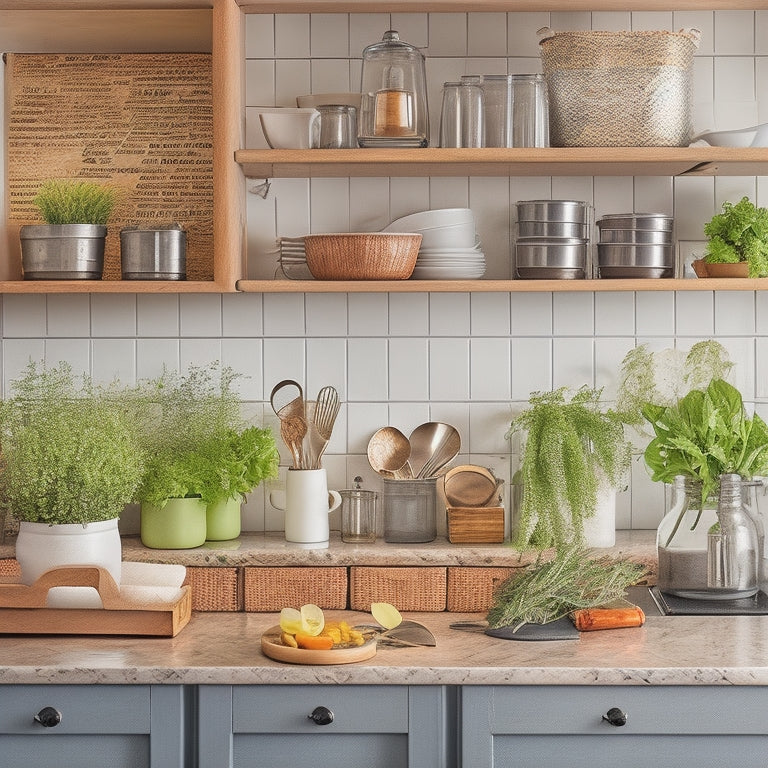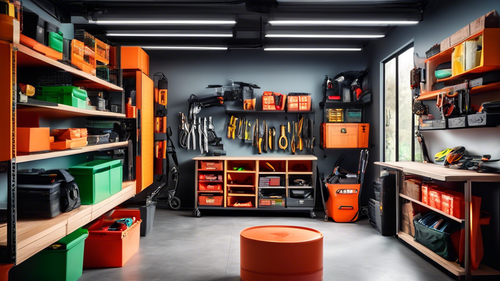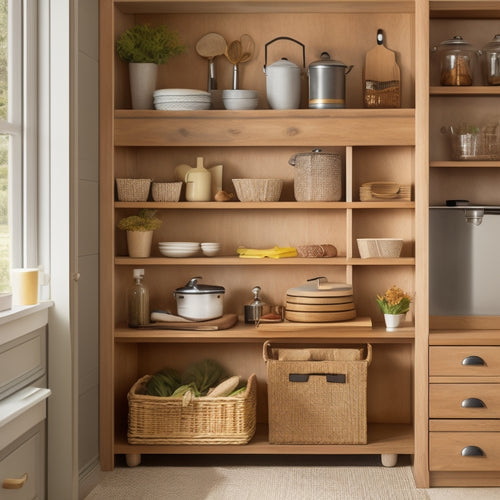
7 Best Organizing Hacks for Small Home Cooks
Share
You'll be amazed at how these 7 organizing hacks can change your small kitchen into a cooking haven! Start by maximizing vertical storage space with shelves, hooks, and hanging organizers. Employ hidden corner areas with corner shelving units and decorative baskets. Then, streamline your countertops by defining zones for cooking tasks and designating spaces for essential items. Organize utensils and gadgets with drawer dividers, utensil trays, and pegboards. Create a functional pantry with categorized items, shelf labels, and baskets. Finally, designate a landing zone for mail and papers, and simplify meal prep stations with assigned areas and labeled containers. As you begin to implement these hacks, you'll uncover even more opportunities to optimize your kitchen's workflow and functionality.
Key Takeaways
- Utilize vertical storage space with shelves, hooks, and hanging organizers to maximize kitchen functionality.
- Streamline countertops by defining zones for cooking tasks and allocating space for essential items.
- Organize utensils and gadgets with drawer dividers, utensil trays, and designated storage for infrequently used items.
- Create a functional pantry by categorizing items, assigning a home for each, and using shelf labels and baskets for quick identification.
- Designate a landing zone for small items like mail, keys, and bags to reduce clutter and maintain order.
Maximize Vertical Storage Space
From floor to ceiling, every inch of your small kitchen counts, and maximizing vertical storage space is key to keeping your cooking essentials within easy reach.
By implementing effective organizational strategies like utilizing vertical space with shelves, hooks, and hanging organizers, you can create a more functional kitchen.
You can make the most of your shelves by using shelf risers, which create additional layers of storage and allow you to stack items without overcrowding.
Install magnetic strips on your walls or cabinets to store metal utensils, spices, or oils, freeing up cabinet space.
Consider a pegboard with hooks for hanging pots, pans, and utensils.
Utilize Hidden Corner Areas
You're likely aware that corners in your kitchen can be notoriously tricky to maneuver, but with the right strategies, you can turn these often-wasted areas into worthwhile storage real estate.
Consider installing corner shelving units that wrap around the bend, providing a snug fit for cookbooks, spices, or infrequently used appliances.
Corner Shelving Units
In a small kitchen, every inch counts, and often, it's the corners that get neglected. However, with corner shelving units, you can turn these forgotten spaces into functional areas for storage and display.
| Corner Shelving Benefits | Decorative Storage Options |
|---|---|
| Maximize corner space | Baskets, bins, or containers |
| Easy access to items | Shelves with decorative trim |
| Keep countertops clear | Hooks for hanging utensils |
Maximize Dead Space
Beyond the obvious benefits of corner shelving units, there are still more opportunities to squeeze out every last bit of storage from your kitchen's hidden areas.
You can install under sink storage units to hold cleaning supplies, scrubbers, and sponges, keeping them out of the way but still accessible.
Another often-overlooked area is the back of a cabinet door. You can attach adhesive hooks or a pegboard to hang spices, oils, or frequently used utensils.
Don't forget to make use of the space inside your drawers by using drawer dividers to separate utensils, cookware, and dinnerware.
Streamline Kitchen Countertops
You'll want to start streamlining your kitchen countertops by strategically placing essential items, like olive oil and spices, within easy reach.
Next, define zones on your countertop for specific tasks, such as a baking zone or a coffee station, to keep related items contained.
Essential Item Placement
Your kitchen countertops are prime real estate, and every inch matters. To optimize this space, focus on essential item placement.
Identify your most-used cooking necessities, such as olive oil, salt, and pepper, and assign them a home near the cooking zone. Essential tools like your chef's knife, cutting board, and Instant Pot should be easily accessible.
Consider a utensil organizer or a knife block to keep frequently used items within reach. By strategically placing these must-haves, you'll streamline your workflow, reduce clutter, and make cooking more efficient.
Countertop Zones Defined
Designate specific zones on your countertop to maintain a seamless cooking experience.
This intentional arrangement will enhance your countertop aesthetics and optimize your appliance arrangement. By categorizing tasks into distinct zones, you'll reduce clutter and increase productivity.
Create the following zones on your countertop:
-
Prep Zone: Reserve a section for food preparation, including a cutting board, knives, and utensils.
-
Cooking Zone: Designate an area for cooking, featuring your stovetop, oven, or cooking surface.
-
Baking Zone: Allocate space for baking essentials, such as a stand mixer, baking sheets, and utensils.
-
Coffee and Beverage Zone: Create a station for your coffee maker, tea infuser, or other beverage-related items.
-
Miscellaneous Zone: Set aside a small area for items like spices, oils, or other frequently used ingredients.
Maximize Corner Space
Now that your countertop zones are defined, it's time to tackle the often-wasted space in the corners. You can install corner drawer solutions to store items like spices, oils, or utensils, keeping them within easy reach.
Consider lazy susan options for your corner cabinets, allowing you to access items in the back without having to dig through everything in front. This will help you make use of the entire space, making it functional and efficient.
Organize Utensils and Gadgets
The utensils and gadgets you've accumulated over time can quickly clutter up your small kitchen, making it difficult to find what you need when you need it.
To regain control, implement these strategies to organize your utensils and gadgets:
- Use drawer dividers to separate utensils from gadgets and group similar items together.
- Invest in utensil trays to store frequently used items, like spatulas and whisks.
- Designate a specific drawer or cabinet for gadgets, like slow cookers and stand mixers.
- Hang a pegboard on a wall or inside a cabinet door to store items like pots, pans, and utensils.
- Store infrequently used gadgets in labeled bins or containers to keep them out of the way.
Create a Functional Pantry
Since you spend a significant amount of time in the kitchen, having a functional pantry can make all the difference in your cooking experience.
Start by taking stock of your pantry inventory: remove everything and sort items into categories like baking supplies, canned goods, and snacks.
Once you have a clear visual of what you have, assign a home for each item and use shelf labels to guarantee everything is easy to find.
Consider using baskets or bins to store small items like spices or oils, and install shelves or a pegboard to maximize vertical space.
Designate a Landing Zone
About half of your kitchen chaos stems from cluttered countertops and misplaced items. By designating a landing zone, you'll create a sense of control and calm in your kitchen.
This zone is where you'll place essential items that need to be dealt with, like mail, keys, and groceries.
To create an effective landing zone, make sure to include these essentials:
- A tray or bin for corralling small items
- A hook for hanging keys or bags
- A spot for mail and papers that need attention
- A small shelf for storing frequently used cookbooks or appliances
- A container for storing takeout menus and coupons
Simplify Meal Prep Stations
Your kitchen's busy hub is where meal prep happens, and clutter can quickly take over. To simplify your meal prep station, start by assigning a specific area for each task. This will help maintain order and efficiency.
| Task | Essential Items | Storage Tips |
|---|---|---|
| Chop veggies | Cutting board, knives | Store knives in a designated block, and keep cutting boards near the sink |
| Marinate proteins | Meal prep containers, ingredient labels | Label containers with contents and dates, and store in a designated fridge shelf |
| Cook grains | Measuring cups, cooking utensils | Store cups and utensils in a nearby cabinet or on a utensil organizer |
| Prepare sauces | Spices, oils | Store spices in a nearby rack, and oils in a designated cabinet |
| Assemble meals | Plates, utensils | Store plates and utensils in a nearby cabinet or on a utensil organizer |
Frequently Asked Questions
What Are Some Creative Ways to Store Infrequently Used Kitchen Items?
You cleverly tuck away those "special occasion" kitchen items, like a secret ingredient, by utilizing magnetic strips for utensils and under shelf baskets for infrequently used gadgets, freeing up precious counter space for everyday essentials.
How Do I Keep My Kitchen Organized With Limited Budget?
You maximize your kitchen's potential on a limited budget by repurposing items, using budget-friendly containers, and embracing minimalistic design. Start by decluttering, then assign a home for each item, and label everything to maintain your newfound organization.
Can I Repurpose Old Furniture for Kitchen Storage?
You can totally repurpose old furniture for kitchen storage! Look for vintage cabinets or repurposed shelves that fit your kitchen's style, then refinish or repaint them to match your decor, and voilà – you've got functional storage without breaking the bank!
What Are Some Space-Saving Ideas for a Small Kitchen Island?
Like a conductor leading an orchestra, you'll harmonize your small kitchen by incorporating a multi-tiered kitchen island with built-in storage solutions, such as baskets, hooks, and shelves, to maximize vertical space and keep essentials within easy reach.
How Do I Maintain Organization Systems Over Time?
You'll maintain organization systems by establishing consistent kitchen routines, regularly evaluating what's working and what's not, and adapting your organization tools as needed to guarantee they remain functional and efficient over time.
Related Posts
-

Clever Ways to Conceal Garage Clutter
Raise your hand if you have a garage full of clutter! Don't worry, you're not alone. A messy garage is a common p...
-

Simplify Your Digital Life in 5 Easy Steps
You're tired of feeling suffocated by digital clutter, stuck in a never-ending cycle of notifications, file disorgani...
-

7 Creative Corner Cabinet Storage Solutions
You're looking to reveal the full potential of your corner cabinets, and you're not alone - maximizing storage in the...


